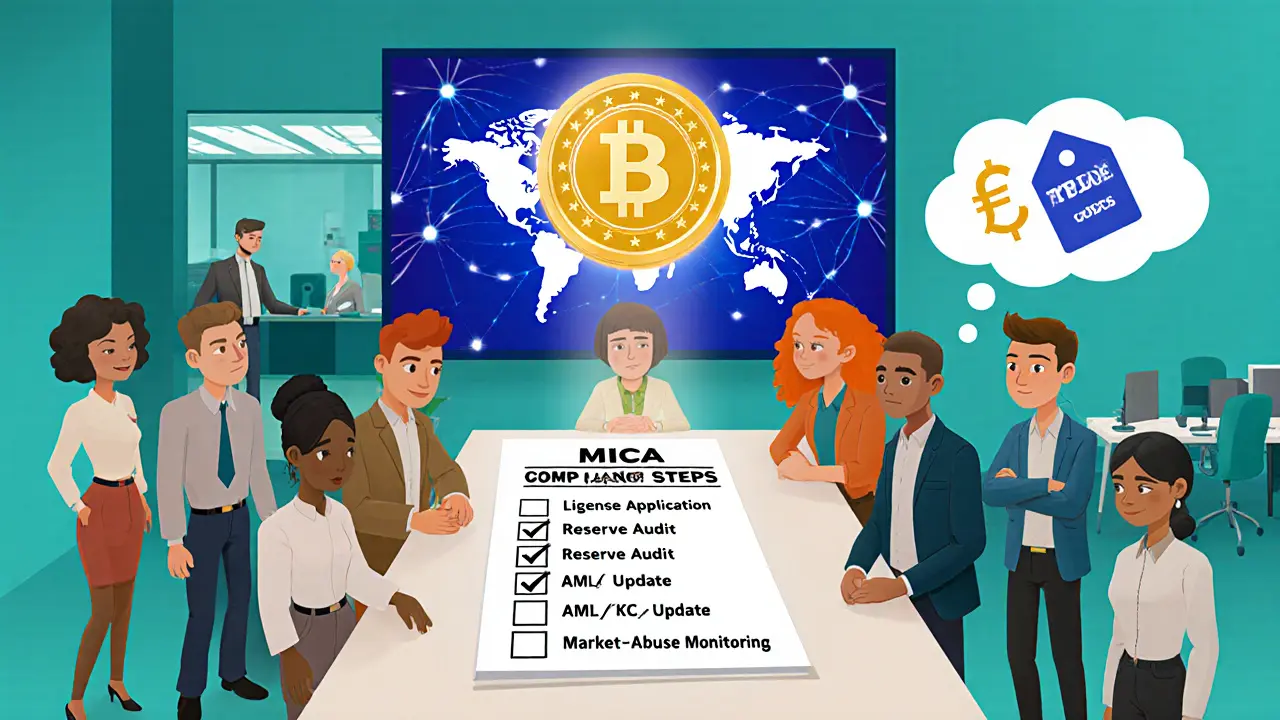MiCA Compliance Checker
Understand Your MiCA Compliance Status
This tool helps you determine if your crypto business meets EU MiCA requirements based on your operations. Enter your business type and key details to see your compliance status and next steps.
Key Takeaways
- The EU’s MiCA regulation became fully effective on December 30, 2024, bringing all crypto‑asset service providers (CASPs) under a single licensing regime.
- Stablecoins - Asset‑Referenced Tokens (ARTs) and E‑Money Tokens (EMTs) - had to meet strict backing and reporting rules from June 30, 2024.
- Member states received flexible transition periods, so compliance dates can differ by up to 18 months.
- ESMA’s enforcement timeline forces non‑compliant stablecoins off EU platforms by March 31 2025, with a sell‑only grace period.
- Firms that ignore MiCA risk hefty fines, loss of passport rights, and forced service interruptions.
When the EU finally hit the switch on December 30, 2024, the crypto world felt a real jolt. MiCA is the Markets in Crypto‑Assets regulation, the EU’s first comprehensive set of rules that treats crypto assets like traditional financial products. It forces everyone from stable‑coin issuers to Bitcoin exchanges to line up with the same compliance playbook across all 27 member states.
Understanding why that deadline matters, how the phased rollout unfolded, and what it means for your crypto business today is key to staying in the game. Below we break down the timeline, the core requirements, and the practical steps you need to take right now.
Why the December 30 2024 deadline matters
Before MiCA, Europe was a patchwork of national crypto rules - some countries embraced stablecoins, others banned them. The deadline unified the market, giving legitimate players a passport to operate anywhere in the EU while shutting down gray‑area services.
It also coincided with Bitcoin cracking the $100,000 mark, turning heads of investors and regulators alike. The timing helped legitimize crypto as a mainstream asset class, but it also raised the bar for compliance dramatically.
Phase 1: Stablecoin rules took effect on June 30 2024
MiCA split its rollout into two blocks. The first block targeted stablecoins - the only crypto assets the EU treated as quasi‑money. Two categories emerged:
| Category | Backing requirement | Reporting | Key compliance step |
|---|---|---|---|
| Asset‑Referenced Tokens (ARTs) | Reserve of multiple assets (currencies, commodities) | Quarterly transparency reports | Publish detailed whitepaper (Art. 6) |
| E‑Money Tokens (EMTs) | 100 % fiat reserve (e.g., € or $) | Monthly reserve attestations | Obtain NCA authorization before issuance |
Both token types had to prove they could cover every issued unit with liquid assets, undergo regular audits, and keep a public reserve dashboard. Failure to do so meant immediate delisting under ESMA’s 2025 enforcement plan.

Phase 2: Full MiCA rollout on December 30 2024
The second block brought the rest of the crypto ecosystem into the regulatory fold. The key focus was on Crypto Asset Service Providers (CASPs) - exchanges, custodians, wallet providers, and token issuers that don’t fall under the stablecoin umbrella.
CASPs now need a license from their national competent authority (NCA), demonstrate:
- Adequate capital based on operational risk (EBA RTS guidelines)
- Robust governance and AML/KYC procedures
- Systems to prevent market abuse, including insider trading and manipulation
- Insurance or guarantee mechanisms for client assets
Once approved, a CASP can use the EU passport to offer services in any member state - but only if every jurisdiction recognises the licence.
Transition periods: How member states stretched the deadline
MiCA gave each country a leeway window to adopt the rules. Some chose a 12‑month transition, others up to 18 months. This discretionary approach means that while the EU‑wide deadline was December 30 2024, you might still see local extensions until mid‑2026 in places like Italy or Spain.
The downside? A fragmented compliance calendar can trap firms in a “wait‑and‑see” mode, delaying product launches and creating uncertainty for investors.
ESMA enforcement timeline - what happened in early 2025
In a January 17 2025 statement, the European Securities and Markets Authority (ESMA) laid out a clear roadmap:
- By end of January 2025, all CASPs must halt services for non‑compliant stablecoins.
- From February 1 to March 31 2025, platforms may keep a “sell‑only” window, allowing users to liquidate holdings.
- After March 31 2025, any stablecoin that hasn’t met the ART/EMT criteria must be completely delisted.
Failure to comply triggers fines of up to €10 million or 2 % of annual turnover, whichever is higher.

Market impact: Opportunities and challenges
MiCA’s arrival sparked two clear trends:
- Increased investor confidence. With clear consumer‑protection rules, institutional money began flowing into EU‑based crypto funds, boosting liquidity for compliant assets.
- Higher compliance costs. Small exchanges struggled to fund the legal, audit, and capital‑reserve requirements, leading some to exit the EU market entirely.
Stablecoin projects that couldn’t prove full backing - like several algorithmic coins - were forced off major exchanges, creating short‑term price volatility but ultimately nudging the market toward more transparent tokens.
What crypto firms need to do now (checklist)
- Confirm your NCA status - have you filed the CASP licence application? If not, start immediately.
- Audit your stablecoin reserves - ensure ARTs and EMTs meet the 100 % backing rule and are publicly disclosed.
- Update AML/KYC procedures to align with the latest EBA technical standards.
- Implement market‑abuse monitoring tools - transaction surveillance, whistle‑blower channels, and trade‑reporting pipelines.
- Plan for a sell‑only period for any non‑compliant tokens still on your platform - communicate deadlines to users.
- Budget for ongoing compliance - factor in legal fees, audit costs, and capital reserves into your financial model.
By ticking these boxes, you’ll avoid the steep fines and keep the EU passport open for cross‑border growth.
Looking ahead: How MiCA will evolve
MiCA isn’t static. The European Banking Authority (EBA) is still rolling out detailed regulatory technical standards (RTS) on capital adequacy, liquidity, and stress‑testing. Expect new guidance on tokenized securities and DeFi‑as‑a‑service in 2026. Staying ahead means keeping a close eye on ESMA press releases and participating in industry consultations.
When did MiCA become fully enforceable?
The full set of MiCA rules, especially the CASP licensing regime, took effect on December 30 2024. Stablecoin‑specific rules started earlier on June 30 2024.
What are the main categories of crypto assets under MiCA?
MiCA splits assets into (1) Asset‑Referenced Tokens (ARTs), (2) E‑Money Tokens (EMTs), and (3) all other digital assets, which fall under the CASP licensing regime.
Do I need a MiCA licence to operate a crypto exchange in the EU?
Yes. Any platform providing custodial, trading, or brokerage services for non‑stablecoin assets must obtain a CASP licence from its national competent authority.
What happens if a stablecoin doesn’t meet ART/EMT requirements?
ESMA requires non‑compliant stablecoins to be delisted by the end of January 2025, with a sell‑only grace period until March 31 2025. Continued offering can result in fines and possible suspension of the CASP licence.
How can small crypto firms manage MiCA’s compliance costs?
Consider joining a compliance consortium, outsourcing audit functions, or focusing on a niche market that doesn’t require a full CASP licence (e.g., non‑custodial wallet services). Some firms also partner with already‑licensed providers to leverage their EU passport.

20 Comments
Lena Novikova
MiCA is just the EU trying to control what they don't understand
Bitcoin doesn't need a license to exist. They're regulating the messenger not the message.
And don't get me started on how they think they can enforce this across 27 countries with zero coordination. LOL.
Olav Hans-Ols
Honestly? I'm kinda glad they're finally getting serious about this. I've seen too many sketchy stablecoins crash and burn. MiCA ain't perfect but at least it's a step toward not getting rug-pulled every other week. 🤝
Kevin Johnston
YES!!! Finally some clarity 😊👏 Let's go EU! Crypto can grow legit now!
Dr. Monica Ellis-Blied
The implementation of MiCA represents a watershed moment in the evolution of digital asset regulation, and it is imperative that all market participants recognize the gravity of this regulatory paradigm shift; failure to comply is not merely a technical oversight-it is a fundamental breach of fiduciary responsibility to consumers, investors, and the integrity of the financial system as a whole.
Rosanna Gulisano
They should have banned crypto entirely
Sheetal Tolambe
This is actually really good for small devs like me. Before, it was a wild west. Now at least we know what rules to follow. Still hard though 😅
gurmukh bhambra
MiCA? More like MI-COVID-CONTROL. They’re using crypto to track us. You think they care about stability? They want to kill decentralization. Check the EBA’s past funding sources. Coincidence? I think not.
Sunny Kashyap
EU always overcomplicate things. Why not just let people trade? So many rules for nothing
james mason
Ah yes, the EU-where innovation goes to be bureaucratized. Honestly, I’m surprised they didn’t require CASPs to submit handwritten letters on parchment with wax seals. Truly, the pinnacle of financial sophistication.
Pranav Shimpi
Most small CASPs cant afford the capital reqs. Its a kill switch for indie projects. And the audits? They use firms that charge 50k just for a check. Thats not regulation thats extortion. #MiCAisBullshit
jummy santh
This regulation is a commendable effort toward financial order, particularly in jurisdictions where the absence of clear guidelines has led to exploitative practices. However, one must also consider the cultural context of financial inclusion in emerging economies, where crypto serves as a lifeline rather than a speculative instrument.
Kirsten McCallum
You’re all delusional. Regulation = control. Control = slavery. You want freedom? Don’t touch crypto.
Henry Gómez Lascarro
Let me explain why MiCA is a disaster disguised as progress. First, the EU doesn't even understand blockchain-they think it's a database with a fancy name. Second, they gave themselves 18 months to enforce rules they didn't even draft properly. Third, they're forcing compliance on firms that operate globally, ignoring the fact that most users aren't even in the EU. Fourth, they're using ESMA like a hammer to crush innovation while letting banks keep their own crypto loopholes. Fifth, they're pretending this is about consumer protection when it's really about central bank dominance. Sixth, the 'passport' system is a joke-some countries ignore licenses. Seventh, they didn't even define what 'market abuse' means in DeFi. Eighth, the reserve requirements for ARTs are impossible to audit transparently. Ninth, they're punishing algorithmic stablecoins while ignoring the fact that fiat itself is algorithmic. Tenth, the whole thing is a power grab disguised as financial reform. Eleventh, the EU has never regulated anything without creating a black market. Twelfth, they're ignoring that crypto's value is in censorship resistance, not compliance. Thirteenth, they're making it harder for refugees and dissidents to access funds. Fourteenth, they're creating a two-tier system where only big players survive. Fifteenth, they're using this to justify future CBDCs. Sixteenth, they didn't consult actual crypto developers. Seventeenth, the enforcement timeline is arbitrary and cruel. Eighteenth, they're setting a precedent that the US will copy-badly. Nineteenth, they think they're the center of the world. Twentieth, they're going to regret this when the next bull run hits and the EU is left with empty exchanges.
Will Barnwell
MiCA’s a joke. They think they can regulate crypto like banks? Bro, Bitcoin’s decentralized. You can’t force compliance on nodes in Kazakhstan. Also, why is ESMA the enforcer? They’re not even a police force. This is just EU bureaucracy flexing.
Lawrence rajini
Finally something that makes sense! 👍 Now we can actually build without worrying about getting shut down next week. Love the clarity on stablecoins too. #MiCAGood
Matt Zara
I think this is a good start. It’s not perfect but it’s better than the chaos before. Small shops are gonna struggle, sure, but at least now there’s a path forward. Let’s help them adapt, not just roast them.
Jean Manel
The compliance costs are a death sentence for 90% of startups. This isn't regulation-it's a wealth transfer from innovators to law firms. And the 'sell-only' window? That's just a fancy way of saying 'we're stealing your assets'.
William P. Barrett
The underlying tension here is between sovereignty and decentralization. MiCA attempts to impose territorial legal order on a network that fundamentally rejects it. Whether this succeeds or fails depends on whether one believes that regulation can contain an architecture designed to evade containment.
Cory Munoz
I get why people are upset about the costs, but I also see how this protects regular users. Maybe we need more support programs for small teams? Like grants or shared compliance tools? Just a thought 😊
Jasmine Neo
MiCA is the EU’s last-ditch effort to maintain relevance in finance. They’re terrified of being outpaced by the US and Asia. The real agenda? Kill decentralized finance so CBDCs can take over. This isn't consumer protection-it's financial colonization.